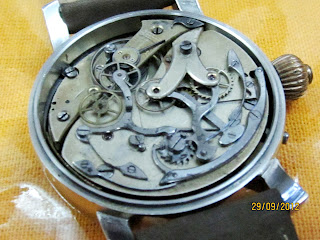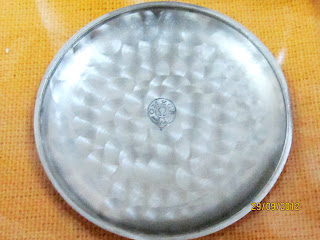RAREST COLLECTION - VINTAGE OMEGA SPLIT SECOND RATTRAPANTE DOUBLE CHRONOGRAPH GENTS WRISTWATCH
BRAND/JENAMA: AUTHENTIC OMEGA SPLIT SECOND RATTRAPANTE GENTS WRISTWATCH
MADE IN/BUATAN: OMEGA SWISS
CIRCA/TAHUN: 1940's
MODEL: SPLIT SECOND RATTRAPANTE DOUBLE CHRONOGRAPH
CRYSTAL/CERMIN: ACRYLIC CLEAN / BERSIH TANPA CALAR
MOVEMENT/ENJIN: LEMANIA BASED CAL. 19N20 17 JEWELS MANUAL WINDING MOVEMENT
DIAL COLOR: SILVER TONE
FUNCTION/FUNGSI: SPLIT SECOND CHRONOGRAPH RATTRAPANTE
HANDS/JARUM: BLACK METAL
MARKERS/TANDA WAKTU: BLACK ARABIC
CASING : SOLID STAINLESS STEEL
LUGS: 20m
MEASUREMENT/UKURAN: 43mm DIAMETER EXCLUDING CROWN and 48mm LUG TO LUG
DITANDA/ENGRAVED BACK CASING: NONE
CROWN: ONION CROWN WITH SPLIT SECOND PUSHER
STRAP/TALI: GENUINE BLACK LEATHER/ KULIT ASLI WARNA HITAM
SIZE STRAP/SAIZ TALI: 8.5"
DISCONTINUED MODEL & HARD TO FIND
PRICE/HARGA: -
PERSONAL COLLECTION - NOT FOR SALE (APPRAISAL VALUE FOR THIS WATCH IS USD20K)
History of Omega Watch Co
The History of a Successful Company Omega was founded by Louis Brandt at La Chaux – de – Fonds, Switzerland in 1848 as a assembly workshop. In 1879, after his death, his two sons Louis Paul and César started the in-house manufacturing so they started having total production control. One year later, Omega moved into a small factory that became a huge one when 12 months later they bought the entire building. In 1903, they both died leaving the company in 24 years old, Paul Emile Brandt’s hands. Because of the crisis that the Second World War left, he had to work really hard in order to face the economic difficulties. He merged Omega with Tissot calling the new company SSIH. The SSIH group continued to grow and multiply under his leadership and, by the seventies, it had become Switzerland’s number one producer of finished watches and number three in the world.
In 1985, the holding company was taken over by a group of private investors under Nicolas Hayek leadership. It was immediately renamed SMH (Société suisse de Microélectronique et d'Horlogerie). SMH had a rapid growth and success becoming today's top watch producer in the world. Named Swatch Group in 1998, it now includes Blancpain and Breguet.
Lemania 19N20 Features stem-wind chronograph rattrapante, 60s, 30min, pillar wheel split second, pusher at 11h sub second Data 19''', Dm= 41.8mm 7/17 jewels f = 18000 A/h power reserve 35h
A watch with a double chronograph has two seconds hands. One hand is superimposed over the other. While one hand moves continuously, the other one can be either stopped, started or reset to zero.
The first push releases both hands. While one continues registering the time, the other hand can be repeatedly stopped. In order to stop and bring both hands to zero a watch has a return pusher. The position of the pusher, controlling the split-seconds function is usually at either 10 or 8 o'clock
The double chronograph was previously called Fly-back second. It was invented in 19th century by Adolphe Nicole. During the 1930s, due to a smaller size the mechanism was able to fit the case of a a wristwatch.
In 1922 Patek Philippe launched into the market its first double chronograph. Today double chronographs (or rattrapante chronographs) can be divided into two subgroups. One comprises chronographs based on in-house movements of different watchmaking companies and the other group contains timepieces based on movements like the Valjoux 7750 from ETA.
The group of the in-house movements began with the Venus series of calibers: 179, 185, 189 and 190. These calibers had a rattrapante pusher on the crown but since 1952 they are no longer in production.
The first split-seconds mechanism based on the ETA-Valjoux 7750 was presented in 1992 at BaselWorld. Today this caliber is the main one used in watches with a split-seconds mechanism.
In 2010, Gallet introduced the first self-winding double chronograph movement powered by two separate mainsprings. The Swiss company's in-house manufactured calibre G330 solved the decade's old issue of decreased accuracy while utilizing the dual recording feature, a characteristic problem with double chronographs. Besides the longer duration (72 hours) between winds, this increase in available power enabled the G330 to maintain certified chronometer level accuracy across the full range of functions.













No comments:
Post a Comment